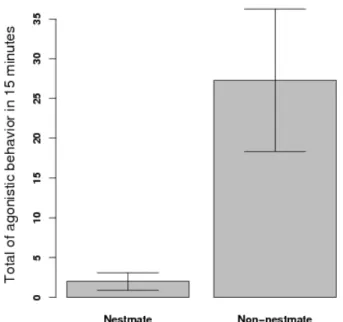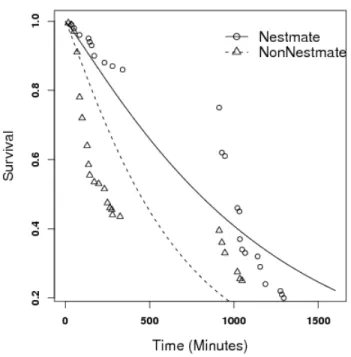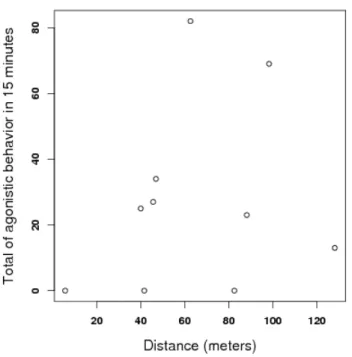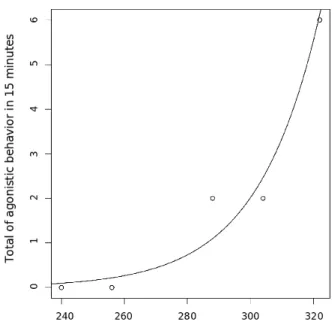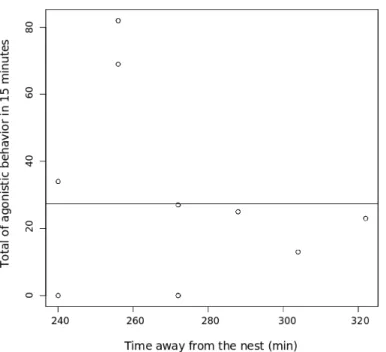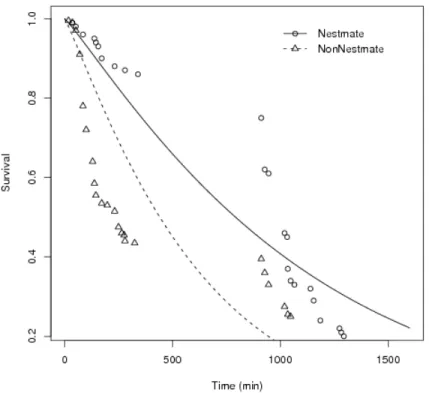AGRESSIVIDADE EM Cornitermes cumulans (KOLLAR) (INSECTA: ISOPTERA) SUBMETIDOS A ESTRESSE
Disserta¸c˜ao apresentada `a Universi-dade Federal de Vi¸cosa, como parte das exigˆencias do Programa de P´os-Gradua¸c˜ao em Entomologia, para obten-¸c˜ao do t´ıtulo de Magister Scientiae.
VI ¸COSA
AGRESSIVIDADE EM Cornitermes cumulans (KOLLAR) (INSECTA: ISOPTERA) SUBMETIDOS A ESTRESSE
Disserta¸c˜ao apresentada `a Universi-dade Federal de Vi¸cosa, como parte das exigˆencias do Programa de P´os-Gradua¸c˜ao em Entomologia, para obten-¸c˜ao do t´ıtulo de Magister Scientiae.
APROVADA: 27 de julho de 2007.
Prof. Rodrigo Ferreira Kr¨uger Prof. Jos´e Henrique Schoereder (Co-orientador)
Prof. Eraldo Rodrigues de Lima Prof. Carlos Ernesto Gon¸calves Reynaud Schaefer
`
A minha m˜ae por ter me ensinado
que a curiosidade ´e a chave da sabedoria,
e ao meu pai por nunca ter se cansado
AGRADECIMENTOS
`
A todos que possibilitaram que eu finalizasse mais essa etapa.
A Universidade Federal de Vi¸cosa.
Minha fam´ılia pelo apoio apesar da distˆancia, e por acreditarem em
mim. Em especial `a minha irm˜a pelas corre¸c˜oes do inglˆes - MUITO obrigada.
Ao meu pai Marcelo Martins Marins e minha m˜ae Jussara Maria
Ma-rins pelas oportunidades que sempre me proporcionaram e pelo exemplo.
`
A minha m˜ae pelo apoio e corre¸c˜oes no texto.
Todos meus amigos que a distˆancia n˜ao separou. E todos grandes
amigos que conheci aqui.
`
A Clara, Alice e D´ebora pelo conv´ıvio, amizade, almo¸cos e jantas
deli-ciosas, e principalmente por fazerem parte do meu lar. `A Elo´a por me dar algo pra
voltar, e n˜ao me deixar sair de ´orbita.
Aos que me ajudaram nas coletas de campo e nos experimentos no
laborat´orio, e compartilharam comigo os carrapatos do pasto, Ana, Dani, Raul e
Elo´a.
Aos motoristas da UFV.
Aos colegas de laborat´orio: Dani, Ana, Fernanda, Cassiano, Marcela e
Tereza. Pelas discuss˜oes, conv´ıvio, companheirismo e ensinamentos.
Ao Rodrigo pelas discuss˜oes e sugest˜oes. Ao Ronaldo, por sempre ter
me ajudado nas d´uvidas das an´alises.
uma disserta¸c˜ao de mestrado, mas fazer ciˆencia e principalmente a escrever sobre ela.
As secret´arias da Entomologia, Paula e Miriam pela prestatividade e
competˆencia.
Ao CNPq pela concess˜ao da bolsa de mestrado.
SUM ´
ARIO
P´agina
LISTA DE FIGURAS . . . vii
LISTA DE TABELAS . . . viii
RESUMO . . . ix
ABSTRACT . . . xi
1 INTRODU ¸C ˜AO . . . 1
2 NESTMATE RECOGNITION INCornitermes cumulans TERMITES (IN-SECTA: ISOPTERA) . . . 4
2.1 Introduction . . . 5
2.2 Material & Methods . . . 6
2.2.1 Collection . . . 6
2.2.2 Experiment . . . 6
2.2.3 Analyses . . . 7
2.3 Results . . . 8
2.4 Discussion . . . 11
3 DOES STRESS INDUCE AGGRESSIVE BEHAVIOUR IN THE TER-MITECornitermes cumulans? . . . 12
3.1 Introduction . . . 13
3.2 Material & Methods . . . 16
3.3 Results . . . 17
3.4 Discussion . . . 22
4 CONCLUS ˜OES . . . 24
LISTA DE FIGURAS
P´agina
1 Total number of aggressive contacts between termites in two groupings: nestmate individuals and non-nestmate individuals (p= 0.018). . . 8 2 Proportion of termite individuals still alive as a function of time spent
after submitted to the agonistic assays presented in Fig.1 (p <0.001). . . 9 3 Total number of aggressive contacts between termites, as a function of
the distance between their original nests in the field (p= 0.54). . . 10 4 Relationship between total sum of aggression and time individuals had
spent away from the nest (in minutes) in a low stress situation p <0.011. 17 5 Relationship between total sum of aggression and time individuals had
spent away from the nest (in minutes) in a high stress situation p <0.001. 18 6 Relationship between total sum of aggression and time individuals had
spent away from the nest (in minutes) in a low stress situation, the line was plotted on the mediam value p= 0.427. . . 19 7 Relationship between total sum of aggression and time individuals had
spent away from the nest (in minutes) in a high stress situation, the line was plotted on the mediam value p= 0.867. . . 19 8 Proportion of termites individuals still alive as a function of time spent
in Petri dish after submited to agonistic assays, in low stress p <0.001. . 20 9 Proportion of termites individuals still alive as a function of time spent
LISTA DE TABELAS
P´agina
RESUMO
MARINS, Alessandra, M. Sc., Universidade Federal de Vi¸cosa, julho de 2007. Agressividade em Cornitermes cumulans (Kollar) (Insecta: Isop-tera) submetidos a estresse. Orientador: Og Francisco Fonseca de Souza. Co-orientadores: Angelo Pallini e Jos´e Henrique Schroeder.
Os insetos sociais possuem a habilidade de reconhecer indiv´ıduos do mesmo ninho e evitar invas˜oes de intrusos no ninho. No entanto, ninhos de cupins s˜ao freq¨uentemente invadidos por artr´opodos, principalmente insetos, incluindo ou-tras esp´ecies de cupins denominados inquilinos. Os mecanismos que determinam a invas˜ao s˜ao pouco conhecidos. Para entender como os indiv´ıduos da esp´ecie cons-trutora do ninho reconhecem esses intrusos, ´e necess´ario entender o processo de reconhecimento entre indiv´ıduos com mesma morfologia e comportamento, por´em de outro ninho. Ainda n˜ao est´a esclarecido se os inquilinos enfraquecem a esp´ecie cons-trutora, visando invadir o ninho, ou se em uma colˆonia previamente enfraquecida, o estabelecimento de inquilinos ocorre mais facilmente. Dessa maneira, ´e plaus´ıvel supor que em uma colˆonia submetida a algum estresse externo, o processo de esta-belecimento de inquilinos seja favorecido. Sendo assim, espera-se que o sistema de defesa desta colˆonia seja menos eficiente, quando comparado a uma colˆonia sem es-tresse. Nesta tese, a principal hip´otese testada foi que a agressividade dos indiv´ıduos da esp´ecie construtora varia em fun¸c˜ao ao estresse a que est˜ao submetidos. Para isso, indiv´ıduos de Cornitermes cumulans (Kollar, 1832) foram submetidos a diferentes intensidades de estresse, dependendo do tempo que permaneceram fora do ninho. Posteriormente, foi mensurada a agressividade e a sobrevivˆencia desses indiv´ıduos em grupos formados por apenas indiv´ıduos do mesmo ninho e em grupos formados por indiv´ıduos de ninhos diferentes. Nas situa¸c˜oes de baixo estresse C. cumulans
ABSTRACT
MARINS, Alessandra, M. Sc., Universidade Federal de Vi¸cosa, July, 2007. Agres-sivity inCornitermes cumulans (Kollar) (Insecta: Isoptera) submit-ted to stress. Adviser: Og Francisco Fonseca de Souza. Co-Advisers: Angelo Pallini e Jos´e Henrique Schroeder.
1
INTRODU ¸
C ˜
AO
Intera¸c˜oes ecol´ogicas entre esp´ecies podem ser positivas, negativas, neu-tras, ou ainda um cont´ınuo entre esses extremos (Price, 1984). Essas intera¸c˜oes re-sultam de um balan¸co entre custos e benef´ıcios para as esp´ecies envolvidas. Esse balan¸co n˜ao ´e fixo, mas pode ser alterado quando certas condi¸c˜oes s˜ao modificadas. Essas condi¸c˜oes podem ser: disponibilidade de recurso, abundˆancia de cada uma das esp´ecies envolvidas, e a presen¸ca (ou abundˆancia) de uma outra esp´ecie nova ao sistema (Begon et al., 2006). Quando se observa alguma altera¸c˜ao nestas intera¸c˜oes, ´e dif´ıcil de identificar quais dessas condi¸c˜oes foram alteradas.
Ninhos de cupins s˜ao freq¨uentemente habitados por indiv´ıduos de ou-tras esp´ecies de cupins denominados inquilinos (Grass´e, 1982). As rela¸c˜oes entre a esp´ecie construtora do ninho e as esp´ecies que o coabitam, ainda n˜ao est˜ao elucidadas. Pode existir uma rela¸c˜ao negativa, se a esp´ecie inquilina prejudicar a construtora, por exemplo, enfraquecendo a estrutura do ninho por se alimentar de suas paredes internas (Eggleton & Bignell, 1997); ou positiva, se a esp´ecie inquilina auxiliar a construtora formando um sistema integrado de defesa que aumente a prote¸c˜ao con-tra predadores de todas esp´ecies coabitantes do ninho (Redford, 1984); ou mesmo, um cont´ınuo entre os extremos.
Existem v´arios registros de ocorrˆencia de inquilinos (Araujo, 1970; La-cher Jr. et al., 1986; Domingos & Gontijo, 1994; Collins, 1980, entre outros), no entanto poucos trabalhos investigam quais s˜ao os fatores que determinam sua ocor-rˆencia. Sabe-se entretanto que, a riqueza desses inquilinos aumenta: (i) com o au-mento do volume do ninho (Coles, 1980; Redford, 1984; Costa, 2005); (ii) na ausˆencia de alados (Costa, 2005); e (iii) quando a esp´ecie construtora do ninho n˜ao est´a pre-sente (Redford, 1984; Costa, 2005).
em cupinzeiros. Al´em disso, um ninho demasiadamente grande pode implicar em menor eficiˆencia de patrulhamento pelos construtores, e assim facilitar a invas˜ao por inquilinos. Estes dois efeitos pressup˜oem que a invas˜ao resulta de intera¸c˜oes entre coabitantes de ninhos mas, mesmo na ausˆencia de tais intera¸c˜oes, um maior volume de ninho pode facilitar a invas˜ao. Ninhos grandes s˜ao necessariamente mais velhos e, assim, est˜ao h´a mais tempo dispon´ıveis para a coloniza¸c˜ao por inquilinos. Assim, se a invas˜ao n˜ao se d´a por intera¸c˜oes negativas entre coabitantes, ent˜ao a maior riqueza de inquilinos em ninhos grandes pode ser consequˆencia simples da idade do ninho.
Costa (2005) coletou diversos ninhos (durante um mˆes no Parque Na-cional das Emas - GO) e verificou que algumas colˆonias estavam produzindo alados, e outras n˜ao. Nas colˆonias sem produ¸c˜ao de alados a riqueza de inquilinos foi maior. Se uma colˆonia n˜ao est´a investindo em reprodu¸c˜ao, em uma ´epoca favor´avel a isso (indicada pela presen¸ca de alados em outras colˆonias), significa que determinados fatores ecol´ogicos (tais como preda¸c˜ao ou competi¸c˜ao) podem estar prejudicando a reprodu¸c˜ao (Begon et al., 2006). Isso pode indicar uma rela¸c˜ao de enfraquecimento da colˆonia com estabelecimento de inquilinos (Costa, 2005).
O fato da riqueza de inquilinos aumentar na ausˆencia da esp´ecie cons-trutora (Redford, 1984) ´e um indicativo que de alguma forma a esp´ecie conscons-trutora inibe o estabelecimento de pelo menos algumas esp´ecies de inquilinos.
Resumindo, o fato de inquilinos ocorrerem em ninhos sem alados, asso-ciado ao fato de a riqueza de inquilinos aumentar na ausˆencia do construtor, nos leva `a suspeita de que de fato a invas˜ao de cupinzeiros (pelo menos por algumas esp´ecies de inquilinos) ´e produto de intera¸c˜oes negativas com o construtor. N˜ao se sabe, en-tretanto, os mecanismos que envolvem tais intera¸c˜oes. Inquilinos podem for¸car sua entrada no ninho, estabelecendo uma rela¸c˜ao quase paras´ıtica com o construtor, ou podem ocupar o ninho de forma oportunista, valendo-se de um enfraquecimento da colˆonia do construtor por motivos alheios `a propria invas˜ao ou ao inquilino.
Se a ocupa¸c˜ao de ninhos ocorre em situa¸c˜oes nas quais a colˆonia do construtor original encontra-se enfraquecida por fatores externos, ´e plaus´ıvel supor que em uma colˆonia submetida a algum estresse externo, o processo de estabeleci-mento de inquilinos seja favorecido. Sendo assim, espera-se que o sistema de defesa desta colˆonia seja menos eficiente, do que de uma colˆonia sem estresse.
foram testadas as hip´oteses de que:
1. C. cumulans, ´e mais agressivo com indiv´ıduos de outras colˆonias do que com indiv´ıduos de sua pr´opria colˆonia;
2. Os indiv´ıduos tem sua agressividade alterada quando sujeitos `a algum tipo de estresse.
2
NESTMATE RECOGNITION IN
Cornitermes cumulans
TERMITES (INSECTA: ISOPTERA)
Alessandra Marins & Og DeSouza
2.1
Introduction
Nest construction by temites requires a great amount of time, energy and building materials, but brings the benefit of providing a safe environment to the colony that builds it. Therefore, to achieve a better benefit/cost ratio, it is imperative to protect the nest against intruders. Despite of that, some termite species are able to invade other species’ nests (Wilson, 1971), establishing their own colonies in the nest along with its builder, or even staying in the nest after the original builder dies. In the Neotropics, mounds of Cornitermes cumulans (Kollar) termites are well known to shelter an enourmous diversity of intruders, either vertebrates or invertebrates. Among those, inquiline termite species are also abundant and diverse (Redford, 1984), some nests holding as much as seven other termite genera (pers.obs.). Differently from the interactions between ants and their social parasites (see Thomas et al., 2005), the strategies that termite inquilines use to break into and inhabit other termites’ nests are mostly unknown. Therefore, any work on that should start from the basics to minimize confounding results. Based on such a premisse, we propose that to understand termite-termite invading strategies, it would be desirable to understand whether nest builders distinguish themselves from other individuals sharing similar morphology and behaviour (that is, conspecifics) but potentially presenting differing colony-specific labels.
2.2
Material & Methods
The experiments were performed using workers (third instar and beyond) collected from five field colonies of C. cumulans (Kollar) (Isoptera, Ter-mitidae), in Vi¸cosa, state of Minas Gerais, in southeastern Brazil. Cornitermes spp. are Neotropical termite species occurring in several habitats, including forests, “cer-rados” (Brazilian savannas) and man-modified habitats, such as pastures or even gardens within cities, where they feed on living and dead grass and herbs (Cancello, 1989). Several species of this genus (among themC. cumulans) build large epigeous nests which are simultaneously inhabited by inquilines, such as other termite genera, ants, beetles, birds, snakes, etc (Redford, 1984).
Experiments consisted of lab assays that measured the agonistic beha-viour and consequent survival times of termite workers confined together in petri dishes. Workers have been assayed because they are known to be the main res-ponsible for termite-termite interactions, including recognition, alarm and agonistic behaviour (Thorne, 1982).
2.2.1 Collection
Fragments of C. cumulans’s nest were collected from five wild colonies in November 2006, in Vi¸cosa, Minas Gerais, Brazil. The nests were marked from 1 to 5 and the distance between them measured in meters. The nest fragments have been extracted from the original nest, placed in a plastic bag, taken to lab, and kept in a constant temperature of 25o
C. In the lab the nest fragments were kept in a plastic tray for c.a. 4 hours. Workers (third instar and beyond) used for the experiment were taken from nest fragment just before experiments began. Soldier’s samples were collected for identification and voucher specimens inclusion in the Termitology Section of the Entomological Museum of the Universidade Federal de Vi¸cosa. Specimens were identified to genus following Constantino (1999), and to species following Cancello (1989).
2.2.2 Experiment
(9 cm of diameter) lined with filter paper to ease mobility of individuals. To start trials, one experimenter placed individuals (10 from each colony or 20 from the same colony) into the Petri dish and passed it on to an observer that did not know if individuals were nestmates or non-nestmates. After one minute had elapsed the observer recorded how many individuals were in agonistic behaviour in that moment. Subsequent instant readings were done every one minute during 15 minutes. For the analysis we used the total sum of agonistic behaviour in 15 readings. This total ranges from 0 (none individuals in agonistic behaviour) to 300 (all 20 individuals in agonistic behaviour in all 15 readings).
After the observation period, Petri dishes were protected from light in order to carry out the survival test, which consisted of checking the number of dead individuals in 2 hours intervals (except from 10 PM to 8 AM), until 32 hours had elapsed or all individuals were dead.
2.2.3 Analyses
Analyses of agonistic assays aimed to check whether grouping type (nestmate or non-nestmate) affected aggressive behaviour. Data were subjected to generalized linear modelling and Quasipoisson errors with log link. Additional analy-sis on the effect of the distance between nests and aggressiveness between termites has been performed using the same statistical procedure. In the survival analysis we checked whether grouping type (nestmate or non nestmate) affected individual sur-vival. To do so, data was subjected to survival analysis under Weibull distribution. Details on such analytical procedures are described in Crawley (2007).
2.3
Results
C. cumulans termite workers presented more aggressiveness towards non-nestmates than to nestmates (Fig. 1, p = 0.018). This differential aggressivity seemed effective enough to lead to mortality as the proportion of nestmates still found alive was higher than the proportion of non-nestmates (Fig. 2, p <0.001).
Figura 1: Total number of aggressive contacts between termites in two groupings: nestmate individuals and non-nestmate individuals (p= 0.018).
2.4
Discussion
As expected C. cumulans was more aggressive towards non-nestmates than to nestmates (Fig. 1), and this aggressiveness resulted in a higher mortality rate in non-nestmate groups (Fig. 2). This seems to evidence that such termites do have the ability to recognize and repel ’selves’. The ability to recognize non-nestmates has been already recorded for some termite species (e.g. Thorne, 1982; Husseneder et al., 1998; Kirchner & Minkley, 2003; Uva et al., 2004; Kaib et al., 2004, among others), and is generally accepted that genetics (Adams, 1991; Husseneder & Grace, 2001), diet (Florane et al., 2004), and even endossimbionts (Matsuura, 2001; Kirchner & Minkley, 2003) would play a role in nestmate recognition. Such factors would assure the colony-specific hydrocarbon profiles which are known to be used as labels for termite-termite recognition (Kaib et al., 2004) but there are reports on the absence of correlation between hydrocarbons and interindividual aggressivity in termites (Florane et al., 2004; Uva et al., 2004).
These findings evidence that C. cumulans are able to recognize non-nestmates and attack them fiercely enough as to provoke the emergence of mortality beyond that expected from lab assay’s stress only. Interesting enough, aggressi-venness, albeit existent, was not modified by the distance between nests Such a recognition and repellence, being not dependent upon nest neighbourhood, seem to indicate that termite workers assayed here either (i) presented no similarity whatso-ever or (ii) were intolerant to any difference in colony-specific labels, no matter how subtle these differences could be. If this is so, we might expect that the enourmous diversity of inquilines known to inhabit C. cumulans nests (Redford, 1984) are not promptly and pacifically accepted into such nests, if detected by the builder. Con-versely, the absence of the builder may correlate with and increment in the diversity and abundance of inquilines, a pattern already noted by Costa (2005) for mounds of
C. cumulans in ‘Cerrados’ (Brazilian savannas).
3
DOES STRESS INDUCE AGGRESSIVE BEHAVIOUR
IN THE TERMITE
Cornitermes cumulans
?
3.1
Introduction
Termitophiles and inquilines, are nest invaders that use the environ-ment built by termites. This association may be only with the nest structure itself or with termites individuals (Collins, 1980). It is plausible to suspect that the pro-cess of invading the host’s nest in termites would be similar to the propro-cess known for ants. To enter and stay in the host colony, intruders of ants nests must bypass chemical recognition of their host (Akino et al., 1999; Lenoir et al., 2001). To do so, two strategies are known: (i) use of offensive chemicals to provoke panic, or decrease the aggressive response of the defenders (Ruano et al., 2005), or (ii) use of visual and olfactory cues, similar to the host, to disguise itself (Dronnet et al., 2005).
Different from the interactions between ants and their social parasites (see Thomas et al., 2005), the strategies that termite inquilines use to break into and inhabit other termites’ nests are mostly unknown. Therefore, any work on that should start from the basics to minimize confounding results. Based on such a premise, we propose that to understand termite-termite invading strategies, it would be desirable to understand whether nest builders distinguish themselves from other individuals sharing similar morphology and behavior (that is, conspecifics) but potentially presenting differing colony-specific labels.
The ability to recognize non-nestmates has been already published for some termites species (eg. Thorne, 1982; Husseneder et al., 1998; Kirchner & Minkley, 2003; Uva et al., 2004; Kaib et al., 2004, among others). So far, these papers have not found a coherent pattern that allows to understand the process of recognition in termite-termite interaction. Apparently termites use a ’buquet’ of components that allow them to be recognize as equals (Thorne, 1982), probably that is why is so difficult for researchers to find which factors are promoting termite identification.
It is plausible to suppose that nestmate recognition occur via related-ness, i.e. the more related two individuals are, more likely for them to be recognized as nestmates. When two individuals share a great amount of hydrocarbons, en-dossimbionts, diet and nesting site, their probability of being related relatives is increased, and consequently their agonistic behavior should be diminished (Kirchner & Minkley, 2003; Kaib et al., 2004; Florane et al., 2004, and papers therein)
2005). It is known that inquiline richness is increased when: (i) increase nest volume (Coles, 1980; Redford, 1984; Costa, 2005); (ii) alates are absent (Costa, 2005); and (iii) original builder are absent (Redford, 1984; Costa, 2005).
The relationship between inquiline richness and nest volume, may exist due to some factors not necessarily independent. A larger nest volume implies more space, therefore it can ease establishment if space is an important limitation. Besides, the increase in nest volume may decrease patrolling efficiency of builder individuals, which may lead to intruders invasion. Both of these effects presuppose a negative interaction between co-habitants. Nevertheless, bigger nests are necessarily older and, therefore, exposed to invasion for a longer period. Thus, if nest invasion does not happen by negative interaction among co-habitants, then a higher inquiline richness in bigger nests may be a simple consequence of nest age.
Costa (2005) collected several C. cumulans’s nests (during a month in a National Park in Goi´as state - Parque Nacional das Emas) and found that some builder colonies had alates and others did not. In the colonies without alates pro-duction the inquiline richness was higher. If a colony is not investing in repropro-duction in a favorable season (shown by the presence of alates in others colonies), imply that some ecological factors (such as predation or competition) may be affecting repro-duction (Begon et al., 2006). This may indicate a relationship with a weaken colony and the inquiline establishment (Costa, 2005). The fact that inquiline richness incre-ases in the absence of the original builder (Redford, 1984) is a clear indication that somehow, the builder restrain establishment of at least some inquiline species.
In conclusion, the fact that more inquilines are found in nests without alates, and the fact that inquiline richness increase in the absence of the original builder, leads us to suppose that termite nest invasion (at least for some inquiline species) is a consequence of negative interactions with the original builder. Neverthe-less, it is not known which mechanisms are involved in such interactions. Inquilines may break into the nest actively facing the builder, or may occupy the nest in a opportunistic way, when the colony is subjected to some kind of stress, therefore deviating energy otherwise used in nest defence.
non-nestmate would change if individuals were subjected to some kind of stress.
3.2
Material & Methods
Due to the difficulty to measure workers stress in the field, we choose to test our hypotheses in lab experiment. In order to simulate different amount of stress in termites individuals, we left the nest fragments in the lab for 16 hours (eight hours longer than Marins & DeSouza (2008)).
Stress was inflicted on termites by keeping individuals away from their nests (albeit within a fragment nest) for a known amount of time, until the assays began. Individuals on which low stress was inflicted spent from 240 to 322 minutes away from their nests. Individuals under high stress spent 960 to 1065 minutes away from their nests.
The material collection and experiment procedures, including how we measure aggressivity and survival, were done according to (Marins & DeSouza, 2008).
3.2.1 Analyses
In the aggressive behavior analysis we checked if both of the explana-tory variables (grouping type and stress) affected the response variable aggressive behavior. The explanatory variables were: (i) Grouping type: nestmate (all 20 indi-viduals in the Petri dish were nestmates) and non-nestmate (10 indiindi-viduals from one colony and 10 from a different one); and (ii) Stress: time away from the nest (amount of time each group of individuals in a Petri dish spent away from nest, ranging from 240 to 322 in low stress and 960 to 1065 in high stress). The data were subjected to generalized linear modelling and Quasipoisson errors with log link (Crawley, 2005).
We also checked if grouping type had influence in survival, using sur-vival analysis with Weibull frequency distribution. Details on such analytical proce-dures are described in Crawley (2007).
3.3
Results
As anticipated by our hypothesis, stress (induced by the time spent away from the nest) did change the patterns of aggressiveness between termite wor-kers.
When we analyse the time effect on agressivity we can see that, nest-mates were affected by time away from the nest(Fig. 4 and Fig. 5), and non-nestnest-mates did not (Fig. 7 and Fig. 6). Nestmates were not aggressive in low stress, but when stress was increased they increase their aggressivity. However, non-nestmates alre-ady presented high levels of aggressivity in low stress and this aggressivity did not increase with stress.
Figura 4: Relationship between total sum of aggression and time individuals had spent away from the nest (in minutes) in a low stress situation p < 0.011.
When we analyse only the grouping type effect on aggressive beha-vior in high stress situation, we saw that there is no statistically difference between nestmate and non-nestmate aggression (Tab. 1).
Figura 5: Relationship between total sum of aggression and time individuals had spent away from the nest (in minutes) in a high stress situation p <0.001.
Tabela 1: Analysis of deviance for the effects of Grouping (Nestmate or non-nestmate) on the total of agonistic behaviour in the first 15 minutes of termite workers in a Petri dish in lab, using Generalized Linear Models with Quasipoisson errors and logit link function. In a high stress situation.
Df Deviance Resid. Df Resid. Dev F Pr(>F)
NULL 14 397.27
Figura 6: Relationship between total sum of aggression and time individuals had spent away from the nest (in minutes) in a low stress situation, the line was plotted on the mediam value p= 0.427.
3.4
Discussion
Marins & DeSouza (2008) confirm thatC. cumulansis able to recognize and attack conspecific intruders. In this article we found thatC. cumulans had their aggressive behavior changed by the stress they were subjected to. However aggression in low and high stress differed among grouping type, namely nestmates and nestmates. Nestmates increased their aggressivity with stress increment, and non-nestmates kept their aggressivity high no matter how stressed they were. These results point that natural stress in individuals may brake social cohesion avoiding nestmates to be recognize as equals.
Although the aggressivity in high stress among nestmates and non-nestmates were statistically similar (Tab. 1), there were changes in survival according to grouping type. Nestmates survived longer than non-nestmates, in both high stress and low stress (Fig. 8 and Fig. 9). This results suggest that nestmates became more aggressive when subjected to some stress, but this aggressivity did not cause high levels of injury as it seems to be the case for non-nestmates.
use by the host conflicts may happen.
4
CONCLUS ˜
OES
1. Em situa¸c˜oes de baixo estresse (tempo longe do ninho de 240 a 322 minutos)
Cornitermes cumulans foi capaz de reconhecer a atacar indiv´ıduos da mesma esp´ecie por´em de outro ninho.
Esse ataque resultou em uma menor sobrevivˆencia no grupo com indiv´ıduos de ninhos diferentes.
2. Em situa¸c˜oes de alto estresse (tempo longe do ninho de 960 a 1065 minutos), a agressividade manteve-se alta para indi´ıduos de ninhos diferentes, e aumentou para indiv´ıduos de mesmo ninho.
Os resultados obtidos nesta disserta¸c˜ao implicam que em situa¸c˜oes de baixo estresse, a esp´ecie C. cumulans ´e capaz de reconhecer intrusos, mas n˜ao h´a uma escala de similaridade entre os indiv´ıduos de colˆonias mais pr´oximas e mais distantes.
´
E esperado que o aumento da agressividade acarrete em uma menor sobrevivˆencia. Isso foi observado para os ind´ıviduos de ninhos diferentes, ou seja, quem brigou mais, morreu mais r´apido.
REFERˆ
ENCIAS BIBLIOGR ´
AFICAS
ADAMS, E. S. Nest-mate recognition based on heritable odors in the termite Mi-crocerotermes arboreus. Proceedings of the National Academy of Sciences of the United States of America, v.88, n.5, p.2031–2034, 1991.
AKINO, T.; KNAPP, J. J.; THOMAS, J. A.; ELMES, G. W. Chemical mimicry and host specificity in the butterflyMaculinea rebeli, a social parasite of Myrmica ant colonies.Proceedings of The Royal Society of London Series B-Biological Sciences, v.266, n.1427, p.1419–1426, 1999.
ARAUJO, R. L. Termites of the neotropical region. In: KRISHNA, K.; WEESSNER, F. (Ed.). Biology of Termites. Academic Press, 1970. p.527-571.
BEGON, M.; TWONSEND, C.; HARPER, J. Ecology: from individuals to ecosystems. Boston, Oxford and London: Blackwell Scientific Publications, 2006.
CANCELLO, E. Revis˜ao de Cornitermes Wasmann (Isoptera, Termitidae, Nasuti-termitinae), 1989. Tese (Doutorado) - Universidade Federal de S˜ao Paulo.
COLES, H. Defensive strategies in the ecology of neotropical termites, 1980. 1-2p. Tese (Doutorado) - Southampton University, U.K. 243pp.
COLLINS, N. M. Inhabitation of epigeal termite (Isoptera) Nests by secundary termites in Cameroun rain forest. Sociobiology, v.5, p.47–54, 1980.
CONSTANTINO, R. Chave ilustrada para identifica¸c˜ao dos gˆeneros de cupins (In-secta: Isoptera) que ocorrem no Brasil. Pap´eis Avulsos de Zoologia, v.40, n.25, p.387–448, 1999.
COSTA, D. A. Inquilinos Associados a Ninhos de Cornitermes cumulans (Isoptera: Termitidae) em uma ´area de campo no Parque Nacional das Emas, GO., 2005. Disserta¸c˜ao (Mestrado) - Universidade Federal de Goi´as, Goiˆania, Brazil.
CRAWLEY, M. The R book. John Wiley and Sons, 2007.
CRAWLEY, M. J. Statistics: an Introduction using R. Wiley, 2005.
DA CUNHA, H. F.; COSTA, D. A.; SANTO, K. D.; SILVA, L. O.; BRANDAO, D. Relationship betweenConstrictotermes cyphergaster and inquiline termites in the Cerrado (Isoptera : Termitidae). Sociobiology, v.42, n.3, p.761–770, 2003. DOMINGOS, D.; GONTIJO, T. A. Multi-occupation of termite mounds in cerrado
vegetation in south-eastern Brazil. Revista Brasileira de Biologia, v.56, n.4, p.717–723, 1994.
DRONNET, S.; SIMON, X.; VERHAEGHE, J. C.; RASMONT, P.; ERRARD, C. Bumblebee inquilinism in Bombus(Fernaldaepsithyrus) sylvestris (Hymenoptera, Apidae): behavioural and chemical analyses of host-parasite interactions. Api-dologie, v.36, n.1, p.59–70, 2005.
EGGLETON, P.; BIGNELL, D. Secondary occupation of epigeal termite (Isoptera) mounds by other termites in the Mbalmayo forest Reserve, southern Cameroon, and its biological significance. Journal of African Zoology, v.111, n.6, p.489– 498, 1997.
FLORANE, C. B.; BLAND, J. M.; HUSSENEDER, C.; RAINA, A. K. Diet-mediated inter-colonial aggression in the Formosan subterranean termite Cop-totermes formosanus. Journal of Chemical Ecology, v.30, n.12, p.2559–2574, 2004.
GRASS´E, P. Termitologia. Paris: Masson, 1982. Iv. 676p.
HUSSENEDER, C.; BRANDL, R.; EPPLEN, C.; EPPLEN, J.; KAIB, M. Variation between and within colonies in the termite: morphology, genomic DNA, and behaviour. Molecular Ecology, v.7, p.983–990, 1998.
KAIB, M.; JMHASLY, P.; WILFERT, L.; DURKA, W.; FRANKE, S.; FRANCKE, W.; LEUTHOLD, R. H.; BRANDL, R. Cuticular hydrocarbons and aggression in the termite Macrotermes subhyalinus. Journal of Chemical Ecology, v.30, n.2, p.365–385, 2004.
KIRCHNER, W. H.; MINKLEY, N. Nestmate discrimination in the harvester ter-mite Hodotermes mossambicus. Insectes Sociaux, v.50, n.3, p.222–225, 2003. LACHER JR., T.; EGLER, I.; ALHO, C.; MARES, M. Termite community
compo-sition and mound characteristics in two grassland formations in Central Brazil. Biotropica, v.18, n.4, p.356–359, 1986.
LENOIR, A.; D’ETTORRE, P.; ERRARD, C.; HEFETZ, A. Chemical ecology and social parasitism in ants. Annual Review of Entomology, v.46, p.573–599, 2001.
MARINS, A.; DESOUZA, O. Nestmate Recognition in Cornitermes cumulans Ter-mites (Insecta: Isoptera). Sociobiology, v.51, 2008.
MATSUURA, K. Nestmate recognition mediated by intestinal bacteria in a termite,
Reticulitermes speratus. Oikos, v.92, n.1, p.20–26, 2001.
PRICE, P. Insect Ecology. New York: John Wiley & Sons,INC, 1984.
R DEVELOPMENT CORE TEAM. R: A Language and Environment for Sta-tistical Computing. R Foundation for StaSta-tistical Computing, Vienna, Austria, 2006. ISBN 3-900051-07-0.
REDFORD, K. The termitaria ofCornitermes cumulans (Isoptera, Termitidae) and their role in determining a potential keystone species. Biotropica, v.16, n.2, p.112–119, 1984.
RUANO, F.; HEFETZ, A.; LENOIR, A.; FRANCKE, W.; TINAUT, A. Dufour’s gland secretion as a repellent used during usurpation by the slave-maker ant
Rossomyrmex minuchae. Journal of Insect Physiology, v.51, n.10, p.1158– 1164, 2005.
THORNE, B. Termite-termite interactions: workers as an agonistic caste. Psyche, v.89, p.133–150, 1982.
UVA, P.; CLEMENT, J. L.; BAGNERES, A. G. Colonial and geographic variations in agonistic behaviour, cuticular hydrocarbons and mtDNA of Italian populations ofReticulitermes lucifugus (Isoptera, Rhinotermitidae). Insectes Sociaux, v.51, n.2, p.163–170, 2004.
